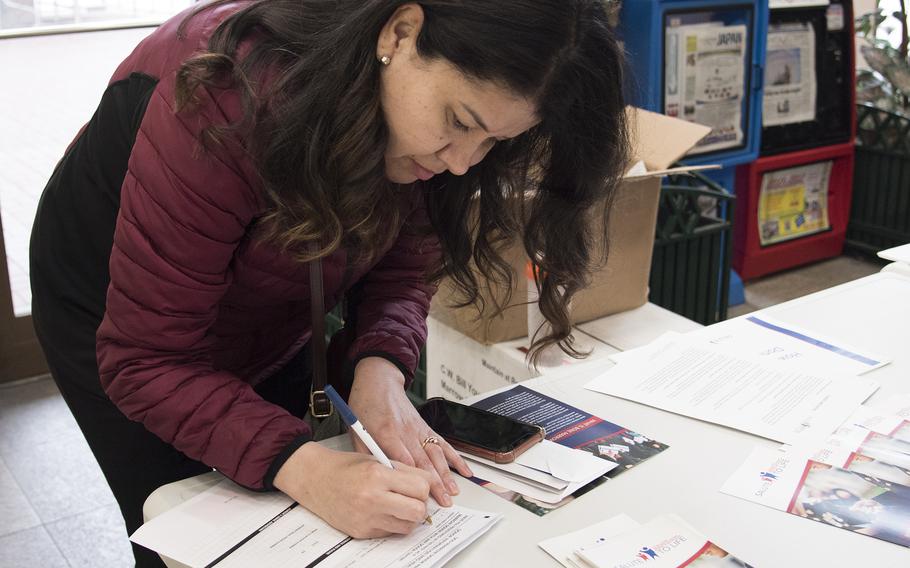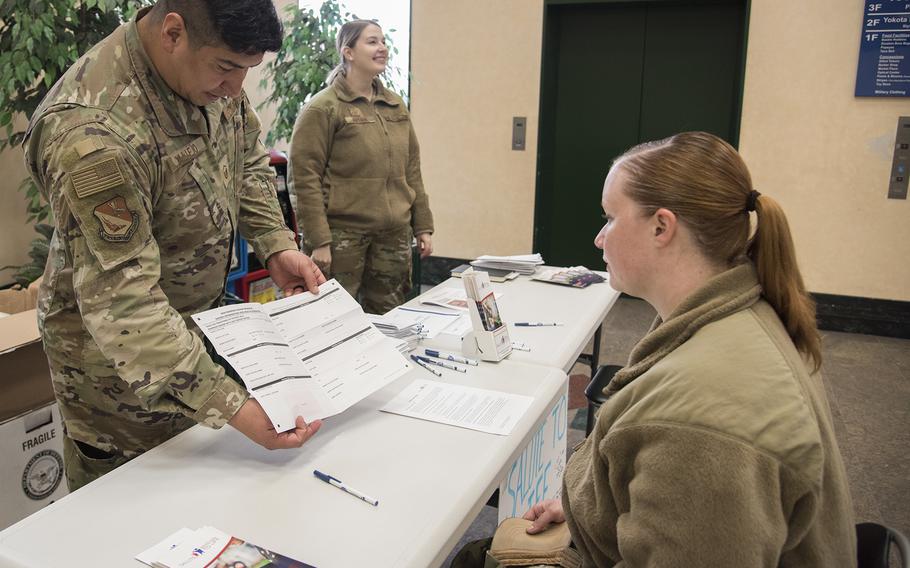
Capt. Sadith Chacon, of the 374th Medical Group, registers as a potential bone marrow donor at the exchange at Yokota Air Base, Japan, on March 28, 2023. (Kelly Agee/Stars and Stripes)
YOKOTA AIR BASE, Japan — Service members, their families and civilian employees at this airlift hub in western Tokyo are enrolling this week in a bone marrow registry that could potentially save a life.
“You never know it could be your neighbor it could be your, you know, your sibling; it can be a family member; it could be the next person you work with that needs a bone marrow transplant,” Capt. Sadith Chacon, 374th Medical Group, told Stars and Stripes while registering to become a bone marrow donor at the Army and Air Force Exchange Service at the air base on Tuesday.
By Tuesday, the four-day enrollment drive had registered 25 prospective bone marrow donors at Yokota Air Base on behalf of Salute for Life, a Department of Defense program. Donor drives like the one at Yokota are the work of volunteers, Master Sgt. Abraham Vallejo, of the 374th Airlift Wing, told Stars and Stripes on Tuesday. Vallejo organized the drive at Yokota, its first, based on his experience with a drive at Osan Air Base in South Korea, his previous duty station, he said.
Salute for Life, created by Congress in 1991, works with active and reserve military personnel, their dependents and DOD civilian employees “to facilitate marrow and stem cell donations,” according to its website. The program since its inception has coordinated more than 8,000 donations.
The Yokota donor drive concludes Friday. Donors may sign up from 8 a.m. to 10 a.m. Wednesday at the Samurai Fitness Center and from 10 a.m. to noon Friday outside the commissary. Donors must be between the ages of 18 and 60.
The next scheduled drive is at Edwards Air Force Base, Calif., from April 14 to 22, according to Salute to Life.
Bone marrow is a source of stem cells, which can be used to regenerate or repair diseased tissues. A transplant involves taking stem cells found in bone marrow, filtering those cells and returning them either to the donor or to another person.
A bone marrow transplant is a special therapy for patients with certain cancers or other diseases, according to the Johns Hopkins University website. More than 17,500 individuals are diagnosed each year with diseases that require a stem-cell transplant, according to Salute to Life.

Master Sgt. Abraham Vallejo, 374th Airlift Wing, explains to Airman First Class Carlie Daggett, 374th Logistics Readiness Squadron, how to register as a bone marrow donor at the exchange on Yokota Air Base, Japan, on March 28, 2023. (Kelly Agee/Stars and Stripes)
A transplant can replace diseased marrow with healthy marrow or regenerate a cancer patient’s immune system that’s been weakened by chemotherapy. Bone marrow transplants have successfully treated leukemias, lymphomas, aplastic anemia, immune deficiency disorders and some solid tumor cancers.
To register with Salute to Life, potential donors provide contact information, age, ethnicity, blood type and any known medical history, which goes to the Salute to Life database. A cheek swab is also collected and sent to the organization’s lab.
“If they are a potential match with someone who needs a bone marrow transplant, Salute for Life will call and inform them,” Vallejo said.
If a donor is matched to a patient, all travel, lodging and medical costs are covered by Salute to Life, and donors are eligible for temporary duty orders, Vallejo said. He said many prospective donors express fear about the procedure.
“A common misconception is that the process of giving bone marrow is super painful,” Vallejo said.
Bone marrow can be taken by either of two methods, he said. In one, the donor is under anesthesia while cells are removed with a needle from their hip bone. Under the other, the apheresis method, the donor is given medication to stimulate the release of stem cells into their blood, which is drawn and screened, Vallejo said.
“I’m really hoping they call me I hope to be a match,” Cachon said. “I’m looking forward to that.”